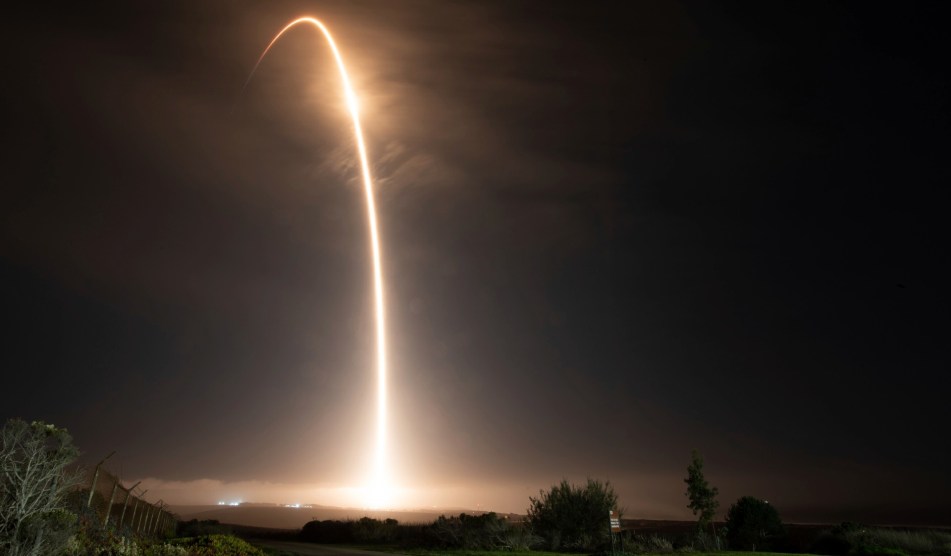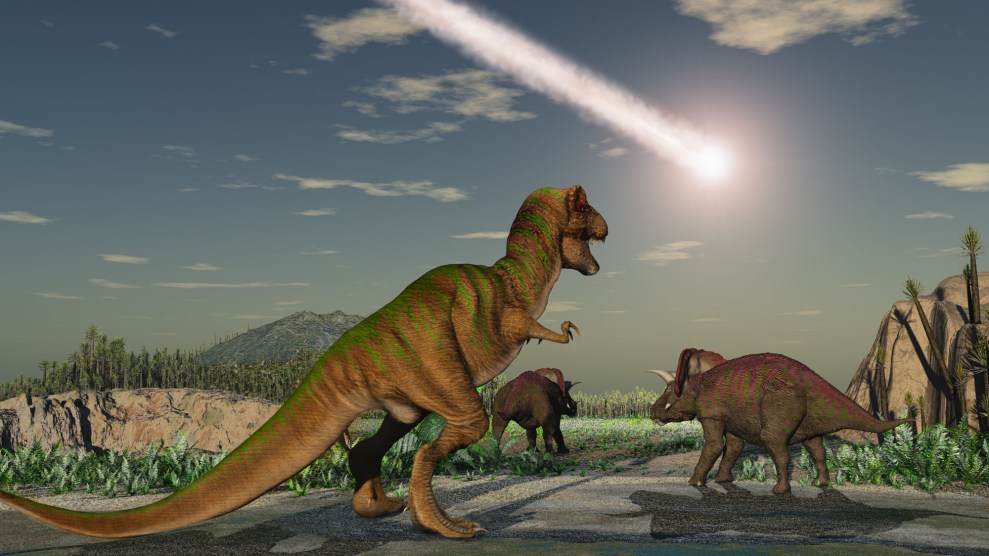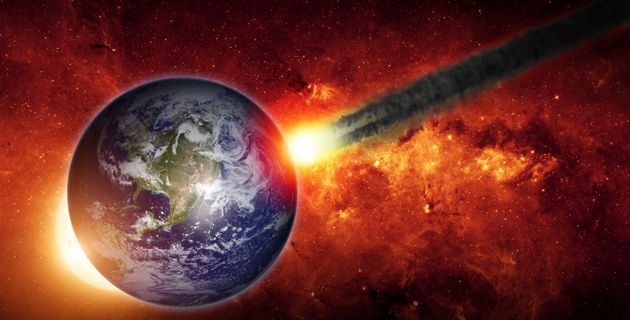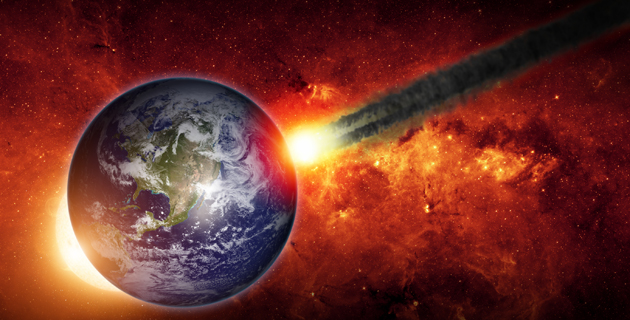
Michael Peterson/AP
This story was originally published by Slate and is reproduced here as part of the Climate Desk collaboration. It also contains spoilers for the film Don’t Look Up.
Streaming just in time for Christmas, Adam McKay’s decidedly uncheery Netflix comedy, Don’t Look Up, finds Jennifer Lawrence and Leonardo DiCaprio playing a pair of intrepid astronomers as they try (and mostly fail) to warn the world about a planet-killing comet that’s hurtling toward Earth. From the beginning, the scientists’ efforts are marked by futility, encapsulated in an early scene in which Kate Dibiasky (Lawrence) and Randall Mindy (DiCaprio) are brought to the White House to debrief President Janie Orlean (Meryl Streep) on the impending extinction-level event.
Predictably, the meeting goes disastrously. The president’s son and chief of staff (played by Jonah Hill) lounges on the couch, nurses a bad case of coke sniffles, and proclaims to be “so bored” by all the world-ending comet talk. Orlean, exhibiting a similar degree of impatience, interrupts the astronomers’ presentation to ask, “What is this going to cost me? What’s the ask here?” before lamenting that the midterms are on the horizon. “The timing is just atrocious,” she opines.
Although the head of NASA’s Planetary Defense Coordination Office, Teddy Oglethorpe (Rob Morgan), advises her that NASA has plans in place to deter such a catastrophe, Orlean decides that the game plan will be to “sit tight and assess” until after the election. The experts in the room are astounded, shocked that political expediency, rather than planetary protection, will dictate the U.S. response to a crisis that is entirely preventable. Sound familiar?
It is scenes like this that lead many critics to see Don’t Look Up as a rather on-the-nose commentary not about rogue comets, but rather America’s failure to address climate change. Writing in the Intercept, Jon Schwarz even compares Don’t Look Up to the heralded nuclear war black comedy Dr. Strangelove, going so far as to suggest that the former might galvanize climate activism in the same way that the latter supercharged the anti-nuclear movement during the Cold War. He is not alone in this view: The overwhelming consensus among critics is that McKay’s new comedy is an allegory for climate change, a film that lampoons our refusal to take sufficient action to deter an all-too-real environmental crisis that is rapidly spiraling out of control.
This interpretation of the film makes sense, and there are good reasons to endorse it. Don’t Look Up is, after all, a movie about a social media–obsessed civilization ignoring scientists as they warn the world about a threat to life on Earth, only to be undermined by politicians and business-folk who prioritize present profits over future peril. It also doesn’t hurt that DiCaprio, who plays a leading role as a bumbling astronomer, is one of the world’s foremost celebrity climate activists. However, while the critical consensus that Don’t Look Up is a climate change allegory is certainly not wrong, this interpretation is also limited.
Yet there’s a flip side to allegorical interpretations: They can also function like blinders, illuminating one viewpoint while crowding out competing ideas.
Calling a movie (or novel) an allegory is often a way of saying that it’s smarter than it appears at first blush. When critics or academics proclaim that George Orwell’s Animal Farm isn’t really a book about talking pigs but totalitarianism, for example, they’re making the case that the novel has a subterranean, secret, and above all more serious meaning. At its most basic, reading allegorically is about digging deeper, going beyond the “surface” of a work that we might otherwise be tempted to dismiss as a fluffy blockbuster or escapist beach reading—like a comedy or science fiction movie—and revealing it as doing intellectual heavy lifting. Yet there’s a flip side to allegorical interpretations: They can also function like blinders, illuminating one viewpoint while crowding out competing ideas.
In the case of Don’t Look Up, insisting that the film is just an allegory for global warming blinds us to the fact that in addition to satirizing our climate inaction, the film draws attention to the fact that the human species is threatened with extinction on multiple fronts: climate change, yes, but also renewed tension among nuclear powers, the possibility of malevolent artificial intelligence, supervolcanoes of the sort lurking beneath Yellowstone, pandemics for which COVID may be a mere dress rehearsal, and, of course, comets.
In academic parlance, we call threats like these “existential risks”: disasters that carry with them the possibility of human extinction or global social collapse from which we could not reconstitute civilization. Yet, unlike climate change, most existential risks are understudied, underpublicized, and underfunded: Toby Ord, an Oxford ethicist and one of the leading scholars on human extinction, often notes that the Biological Weapons Convention—the international body whose job it is to prevent human extinction through biological warfare—has an annual budget of less than $2 million. As Ord likes to point out, that operating budget is smaller than that of the average American McDonald’s franchise. Like Don’t Look Up, it’s a fact so scary it might make you laugh if it doesn’t make you cry.
One of the strengths of McKay’s film is not only that it draws attention to how unprepared we are—both institutionally and culturally—to confront existential risks. It also shines a spotlight on the danger of allowing politicians and businesses, rather than scientists, to run point when it comes to threats to the human species. In Don’t Look Up, this dynamic is brilliantly spoofed in the form of a Silicon Valley tech guru—and “third richest human ever”—named Peter Isherwell. Sporting the vacant stare of a man who just chased three hours of hot yoga with a couple of bong rips, Isherwell speaks in a squeaky mix of tech jargon and New Age chakra-chatter.
However, Isherwell’s innocuous bearing also obscures his inner cunning: He has discovered that the doomsday comet contains “$32 trillion worth of materials” necessary to produce smartphones and computers. Before you know it, he has convinced the president to abandon NASA’s mission to save Earth by blowing the comet off course with nuclear weapons. Instead, the federal government partners with Isherwell’s company, BASH, to devise a scheme to break the comet up into manageable pieces so that it can be stripped of its precious resources. As if on cue, the comet becomes a hero to the American right—“We’re for the jobs this comet will provide,” intones one character—as Isherwell waits patiently for the space rock to line his pockets.
This might all sound far-fetched—the stuff of comedy whimsy—were it not for the fact that Isherwell is clearly a sendup of real-world tech billionaires like Elon Musk and Jeff Bezos who are very much convinced that saving the human species from extinction might be extraordinarily lucrative. When Musk professes that his only goal in life is to terraform Mars so as to prevent human extinction—and that this is the only reason he is interested in accumulating wealth—we often dismiss such claims as the ravings of a megalomaniacal psychedelics enthusiast. Yet the SpaceX CEO puts his money where his mouth is: He sits on the board of Cambridge University’s Centre for the Study of Existential Risk, an organization to which he has donated $10 million.
Musk is not the only Silicon Valley slickster obsessed with human extinction: Jaan Tallinn (formerly of Skype) co-founded the CSER alongside the world-renowned astronomer Martin Rees. Open Philanthropy, the brainchild of Facebook co-founder Dustin Moskovitz, has recently pledged to donate more than $10 million to the Future of Life Institute, another human extinction think tank situated in Cambridge, Massachusetts. As for Bezos, his interest in saving the human race stretches all the way back to his 1982 high school valedictorian speech, during which he professed that “space is the only way to go” if we are to give our species a chance for a long tenure.
To be clear, I am not against billionaires throwing money at existential risk research—I’m glad someone is! Indeed, this Silicon Valley enthusiasm for preventing human extinction would be all well and good were it not for the fact that it is often hard to disentangle Musk’s and Bezos’ go-to-space-to-save-the-race schemes from their desire to profit from them. Like McKay’s character Isherwell, a growing number of tech titans not only view the cosmos as the final frontier for their fortunes, but are particularly enthusiastic about the promise of the kind of asteroid mining that Don’t Look Up mines for laughs.
Google co-founder Larry Page has recently pumped money into an asteroid-mining startup named Planetary Resources, while the Winklevoss twins have taken to arguing that cryptocurrency is a better long-term investment than gold since the latter will become devalued once Musk gets his asteroid mining operation up and running. As for Musk himself, he has remained cagey regarding his plans for space mining, yet as always his actions speak louder than words: In 2020, his company SpaceX won the lucrative contract for NASA’s Psyche mission. The goal? To “study” a massive asteroid chock-full of profitable heavy metals.
Some, like Martin Elvis of the Harvard-Smithsonian Center for Astrophysics, have argued that profits and planetary defense need not be mutually exclusive. In Elvis’ view, asteroid mining will create a “virtuous cycle” in which the desire to strip-mine the cosmos will drive comet research, and comet research will keep us safer from extinction by identifying those big bad space rocks that might snuff us out. That argument sounds good, but it also sidesteps a critical question: What might happen if the interests of the human species don’t line up perfectly with those of big business?
It is precisely this scenario that Don’t Look Up imagines, a warning that gets lost if we view the film only as a climate change allegory. Here, McKay both highlights the existential risk inherent to a nation that devalues scientific expertise—leaving us vulnerable to threats like climate change, COVID, and comets—and demonstrates how difficult it can be to separate a genuine desire to do good from the desire to turn a profit.
In this way, the film’s depiction of Isherwell is extremely savvy, resisting lazy villainizing: The BASH CEO is not presented as some fast-talking cynic who knows the Earth is doomed and doesn’t care. Rather, he is portrayed as a starry-eyed true believer, prone to waxing rapturous about the poverty-eliminating potential of the comet’s heavy metals. When a character accuses him of being a “businessman,” he becomes gravely (and hilariously) offended, proclaiming, in seeming earnestness, that his interests are solely virtuous. For Isherwell, the comet-busting mission is not just about precious materials; he insists that nothing less than “the evolution of the human species” is at stake.
And he’s right, of course, just not in the way he thinks. The film ends not with a whimper but a bang: The BASH mission fails and the comet slams as predicted into our Big Blue Marble, splitting the planet apart. When the camera pans out to survey the debris, we see smartphones, cars, and desiccated trees strewn amid the Earth’s mantle, a monument to our feeble will and our misplaced faith that technology, rather than cultural transformation, will save us. As both the film and the human species cut to credits, we are left with a prescient warning: about the hubris of billionaires, the corruption of politicians, a myopic American culture that gives rise to both, and a nation that is woefully unprepared to lead the world in the face of any existential risk, whether the threat be climate change or a careening comet.
















